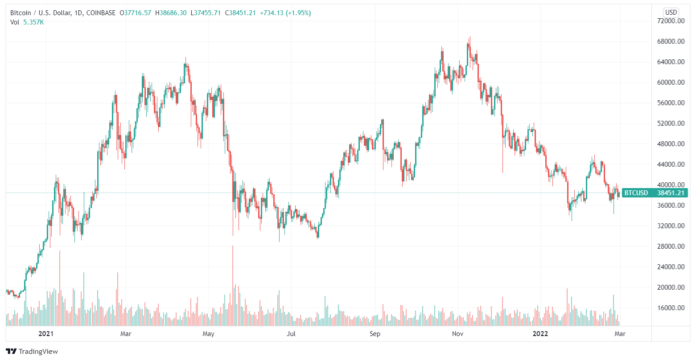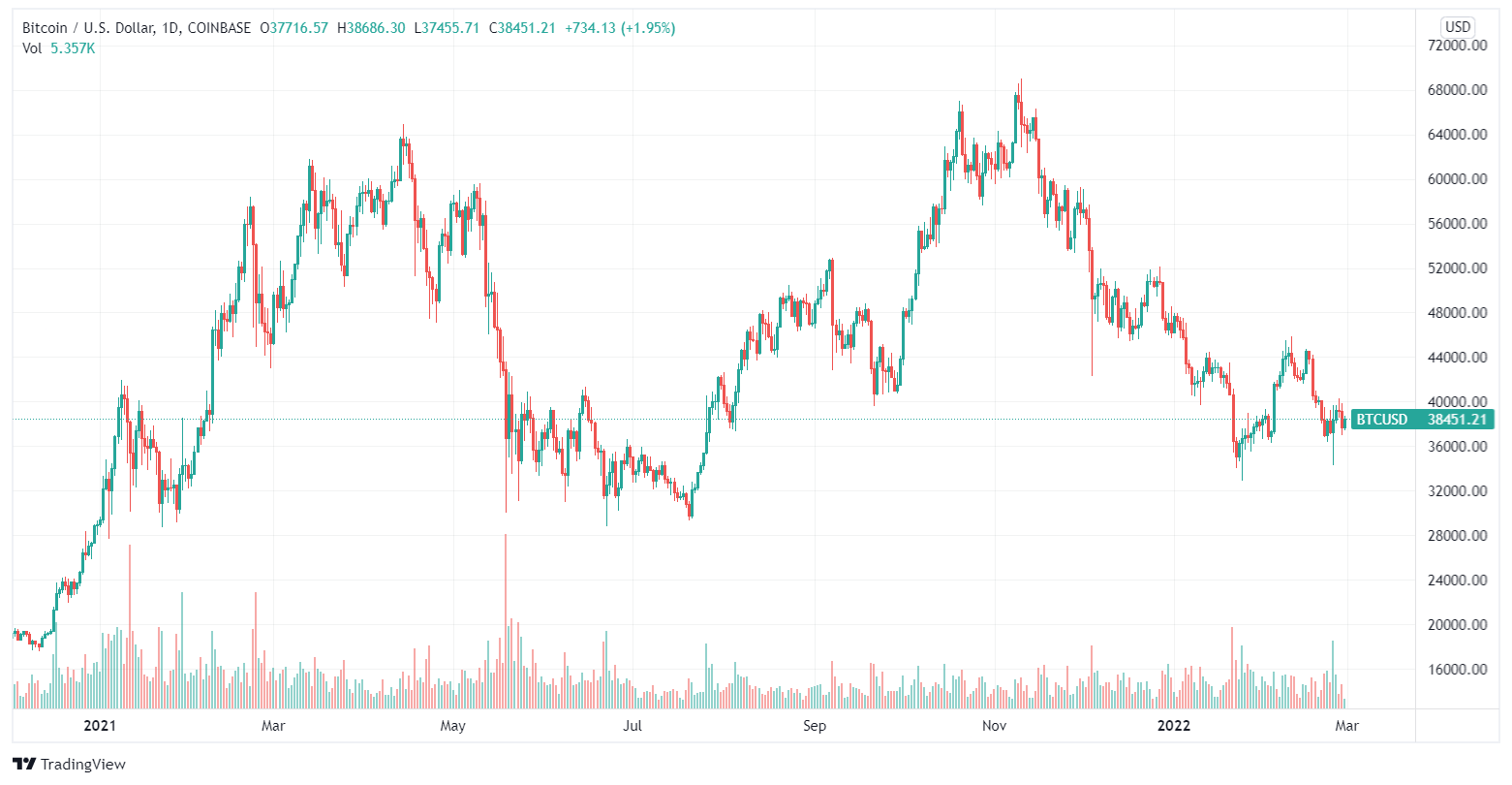
Good Morning!
The crypto market has started to recover a bit, but is still very vulnerable as all eyes have been on the Ukraine over the weekend. There is plenty of news and materials covering the different aspects and views involved in the critical situation within the Ukraine. It is impossible to foresee or predict the outcome. Russia is heavily sanctioned by being cut off from the SWIFT system, but seems to be unimpressed by the rising pressure on them by NATO.

Conflict in the Ukraine
As mentioned previously, the current situation requires a great deal of background information in order to make any well-balanced statements at all. The history of Russia runs deep, having its beginnings in the North (Novograd) in 862. In 882, Kiev (the capital city of the Ukraine) was seized for uniting the northern and southern lands of the Eastern Slavs under one authority. Going into intricate details this far back in history goes beyond the scope of this commentary, so let me instead touch on the dissolution of the Soviet Union, which occurred between 1988 and 1991.
There were many factors that led to the collapse of the Soviet Union, including political policies, economics, defense spending, and the nuclear accident in Chernobyl in 1986. While it is, for all practical purposes, impossible to pinpoint a single cause for an event as complex and as far reaching as the dissolution of a global superpower, a number of internal and external factors were certainly at play in the collapse of the U.S.S.R.
Economic problems in the Soviet Union
The primary domestic goals of soviet leader Mikhail Gorbachev were to jump start the moribund Soviet economy and to streamline the cumbersome government bureaucracy. When his initial attempts at reform failed to yield significant results, he instituted the policies of “glasnost” (openness) and “perestroika “(restructuring). In the end, Gorbachev’s reforms and his abandonment of the “Brezhnev Doctrine” hastened the demise of the Soviet empire.
In 1990, the Soviet economy was the world’s second largest, but shortages in consumer goods were routine, and hoarding was commonplace. Economic stagnation had hobbled the country for years and the “perestroika” reforms only served to excacerbate the problem. It was a widely held belief that Soviet defense spending accelerated dramatically in response to the presidency of US president, Ronald Reagan, and proposals such as the strategic defense initiative. In fact, the Soviet military budget had been trending upward since at least the early 1970s.
Cold war era
In addition to budgetary matters, Soviet involvement in Afghanistan was a key military factor in the break of the U.S.S.R. McDonald’s opened its first restaurant in Moscow in January 1990, and it seemed like a triumph of Western capitalism as customers lined up around the block for their first taste of a Big Mac. Throughout the Cold War, the Soviet Union and the United States teetered on the edge of mutual nuclear destruction.
Gorbachev had been in power for just over a year when in April 1986 the Unit 4 reactor at the Chernobyl power station in Pryp’yat (now in the Ukraine) exploded. On December 25, 1991 the Soviet hammer and sickle flag was lowered for the last time over the Kremlin, thereafter to be replaced by the Russian tricolour. Mikhail Gorbachev resigned his post as president of the Soviet Union, leaving Boris Yeltsin as president of the new independent Russian state.
Ukraine’s independence
We wish all of you a good week!
All intellectual property, proprietary and other rights and interests in this publication and the subject matter hereof are owned by Crypto Broker AG including, without limitation, all registered design, copyright, trademark and service mark rights.
Disclaimer
This publication provided by Crypto Broker AG, a corporate entity registered under Swiss law, is published for information purposes only. This publication shall not constitute any investment advice respectively does not constitute an offer, solicitation or recommendation to acquire or dispose of any investment or to engage in any other transaction. This publication is not intended for solicitation purposes but only for use as general information. All descriptions, examples and calculations contained in this publication are for illustrative purposes only. While reasonable care has been taken in the preparation of this publication to provide details that are accurate and not misleading at the time of publication, Crypto Broker AG (a) does not make any representations or warranties regarding the information contained herein, whether express or implied, including without limitation any implied warranty of merchantability or fitness for a particular purpose or any warranty with respect to the accuracy, correctness, quality, completeness or timeliness of such information, and (b) shall not be responsible or liable for any third party’s use of any information contained herein under any circumstances, including, without limitation, in connection with actual trading or otherwise or for any errors or omissions contained in this publication.
Risk disclosure
Investments in virtual currencies are high-risk investments with the risk of total loss of the investment and you should not invest in virtual currencies unless you understand and can bear the risks involved with such investments. No information provided in this publication shall constitute investment advice. Crypto Broker AG excludes its liability for any losses arising from the use of, or reliance on, information provided in this publication.
The post Market commentary, 28.02.2022 appeared first on Crypto Valley Journal.




